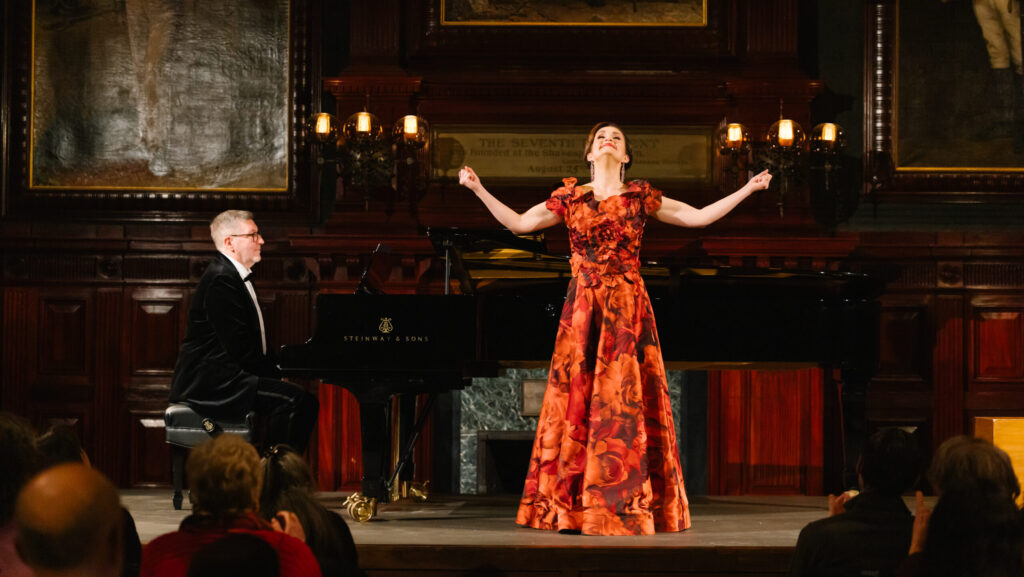

Da Ping Luo
Ricky Ian Gordon’s setting of Emily Dickinson’s “We must always not thoughts so small a flower” tells of a single blossom we’d barely discover in a backyard fading out of season. The recital—conceived by soprano Erin Morley and pianist Gerald Martin Moore—is a far cry from easy. Constructed on themes of nature—flowers, timber and birds particularly—it’s an audacious, ingenious combine of fabric, brilliantly conceived and fantastically carried out.
The beautiful Gordon tune group, which was first offered in Washington final spring, was a New York premiere and set the tone each musically and textually. Without delay historically lyrical and distinctly modern, the settings of various authors communicate to the vary of images that flowers can convey—Dickinson’s sweet-sadness adopted by satirical chunk from Dorothy Parker, and extremely efficient, poignant settings of much less well-known writers together with Jane Kenyon, Donald Corridor, and Telmo Dos Santos. The piano elements for this cycle are notably complicated, as had been many others all through the live performance, with Moore proving himself as a lot a virtuoso as Morley.
“Virtuoso,” although, could also be a charged phrase right here. There’s little question Morley is thought for her talent in coloratura and astonishing ease on the very high quality—Olympia’s “Les oiseaux dans la charmille” with dazzling ornaments has been a longtime signature piece. In reality, she made her Met debut in 2008, however her voice and method are amazingly untouched by time, her accuracy so pinpoint, her tone so true that I generally assume her performances must be a supply for transcriptions.
But there’s extra there. Listening to her, I remembered a narrative I as soon as learn concerning the nice German soprano, Rita Streich. When she was launched to somebody as a virtuoso coloratura and Mozart-and-Strauss specialist, she pointedly mentioned she additionally thought-about herself equally a recitalist and Lieder singer. And she or he was proper—great as Streich is in Mozart’s stratospheric live performance arias and as Zerbinetta, a few of her loveliest work is in easy songs.
That is true for Morley too, and fortunately the recital gave her alternatives to point out each side in full bloom. Saint-Saens’s “La libellule” (“The Dragonfly”) is a mini pageant of roulades, trills, and acuti: each trick within the coloratura playbook. Julius Benedict’s “La Capinera,” remembered by report collectors by a treasurable Victor 78 by Amelita Galli-Curci, affords an arching melody that can also be fiendishly troublesome. To those and others, Morley introduced flawless method and beautiful, rounded tone.
However a lot of the recital was extra lyrical—easier in some methods, but in addition calling on different vocal and interpretive assets. Rachmaninov’s acquainted however all the time welcome “Lilacs” and Robert Schumann’s “Der Nussbaum”—these are items for extra introspection, and which lie extra centrally within the center register. Each are qualities that Morley has cultivated very efficiently, as her latest assumptions of Pamina and Gilda on the Met reveal—simply as this recital additionally did.
I’ll significantly treasure the reminiscence of three items. Saint-Saen’s “Le rossignol et la rose” is a fascinating vocalise to which Morley introduced beautiful silvery arcs of sound. (In reality, it was additionally a Rita Streich specialty.) Her encore of Ivor Novello’s sentimental “We’ll collect lilacs within the spring” was exquisitely easy. However for me, the largest shock was Zemlinsky’s “Voglein Schwermut,” a tune I didn’t know, which mixes melodic grace with a powerful dose of that disquieting, neurotic vitality so attribute of Fin-de-siècle Vienna. Morley adopted this with Berg’s “Die Nachtigall”—and absolutely I’m not the one particular person within the viewers who puzzled—may she be Lulu?